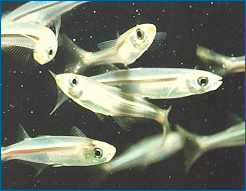
David’s curiosity about body size evolution in fish was first piqued by other research. He had been studying sex determination in fish — what factors determine whether a fish becomes male or female. Unlike in humans (where sex is determined by our chromosomes), David discovered that sex in Atlantic silversides – a silvery fish five or six inches long – is determined by temperature: larvae reared in warm water become males and larvae reared in cooler water become females. To study this, he collected fish eggs from different places on the east coast and reared them all in his lab — and in the process, he noticed something else surprising: fish collected from colder waters grew much faster than fish collected from warmer waters. It turns out that in colder climates, fish are only able to grow during the summer when its warm — and so they are adapted to fit all their growth into a few short months. But in southern climates, fish can grow more continuously and are not adapted for such rapid growth.
That observation tipped David off that growth rate – and hence body size – might evolve pretty easily in fish. Meanwhile, other evidence regarding fish in wild populations was piling up; reports from fishermen and scientific studies suggested that many wild fish were smaller on average than in the past and that they were reaching maturity at smaller sizes than in the past. David put those observations together and reasoned that fish were evolving smaller body sizes because humans collect, or “harvest,” the biggest fish — a form of artificial selection.
Want to know more about how wild fish populations are changing? Take a side trip to The Case of the Shrinking Fish.
Get tips for using research profiles, like this one, with your students.
